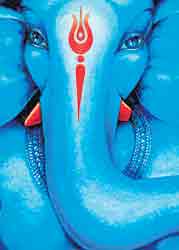
Ganesh in all his gloryAmong the virtues commonly attributed to artists, modesty, it can confidently be said, is not to be found. As the famous 20th century art historians Rudolf and Margot Wittkower observe in their book, Born Under Saturn: The Character and Conduct of Artists, “There is an almost unanimous belief among (laymen) that artists are, and always have been, egocentric, temperamental, neurotic, rebellious, unreliable, licentious, extravagant, obsessed by their work, and altogether difficult to live with.”If this is what these eminent scholars wrote in 1963, I feel that it is justified to say that the trouble with an artist like Mahen Chanmugam (43) is that he is just too modest. How he quietly and unassumingly built up his impressive body of work over a number of years, without keenly pursuing the option to put it up for public display is just one typical example of how Mahen thinks of himself as an artist.
For Mahen Chanmugam painting Lord Ganesh, the deity with the elephant head, started off as a personal journey and was not at all inspired by religion, nor is his work meant as religious art. “Lord Ganesh is universal and the philosophy surrounding him is Buddhist as much as it is Hindu. I subscribe to these philosophies, but I was always more compelled to create something rather than represent something,” he says. Born in Sri Lanka, he was brought up in a family that converted from Hinduism to Christianity three generations ago. His first memories of Ganesh imagery were the dark earthy pigments of the temples he visited with his father as a child. The first experiments with the subject came quietly, by a mixture of chance and intuition. In 1994, while working and living in Singapore, Mahen began a study of the iconography and symbolism of Lord Ganesh. He started exploring the ancient guidelines such as the classic postures for perfect poise within the 32 forms Lord Ganesh appears in and translated these into a contemporary picture. The intensity of the search for new content in classic form, added an intellectual ambivalence to his work, perhaps originating from an unwillingness to commit to a definite position on what Lord Ganesh should represent. Whereas the image topic is constant, the paintings capture a range of emotions and themes. In a modest self-effacing way his art addresses social issues, taboos and artistic conventions. His paintings do challenge an ever more prevailing system of thought that humanity is categorized according to the god they worship. After all, Ganesha is also the destroyer of vanity, selfishness and pride and the personification of material universe in all its various magnificent manifestations. In response to the 2002 bombings on the Indonesian island Bali, Mahen painted Lord Ganesh dressed in the school colours of his old Christian school uniform, the deity’s hands displaying the V-sign in a bid for peace.
In 2007 he discovered the existence of Vinayaki, the manifestation of Lord Ganesh in a female form and this became his next fascination.“Because there are such few visual examples it is for me as an artist a total liberation from the 32 classic postures and forms - and it gives me a licence to be more interpretive,” he explains. While he has been painting since childhood Mahen has no formal schooling. At the age of 16 he started working in printing, quickly moved on to graphic design and left Sri Lanka to work in Hong Kong and Singapore. “I have always had this amazing determination that I wanted to be an artist.” At a younger age, Mahen was interested in surrealism, Dali, Ernst, Magritte but also the British artist duo Gilbert & George. Like many Sri Lankans he has his cultural roots in the East and West though the artist admits his personal visual library is definitely Asian. His work is largely inspired by temple motifs and sculpture, especially the pre Gandhâra style of art when sculptors used the process of visualization through meditation to cut the stylized image straight out of the rock, unlike the Greco-Buddhist art which focused on using plum lines and frames for measured, planned realism. |
|
||||||
|| Front
Page | News | Editorial | Columns | Sports | Plus | Financial
Times | International | Mirror | TV
Times | Funday
Times || |
| |
Reproduction of articles permitted when used without any alterations to contents and a link to the source page.
|
© Copyright
2008 | Wijeya
Newspapers Ltd.Colombo. Sri Lanka. All Rights Reserved. |
